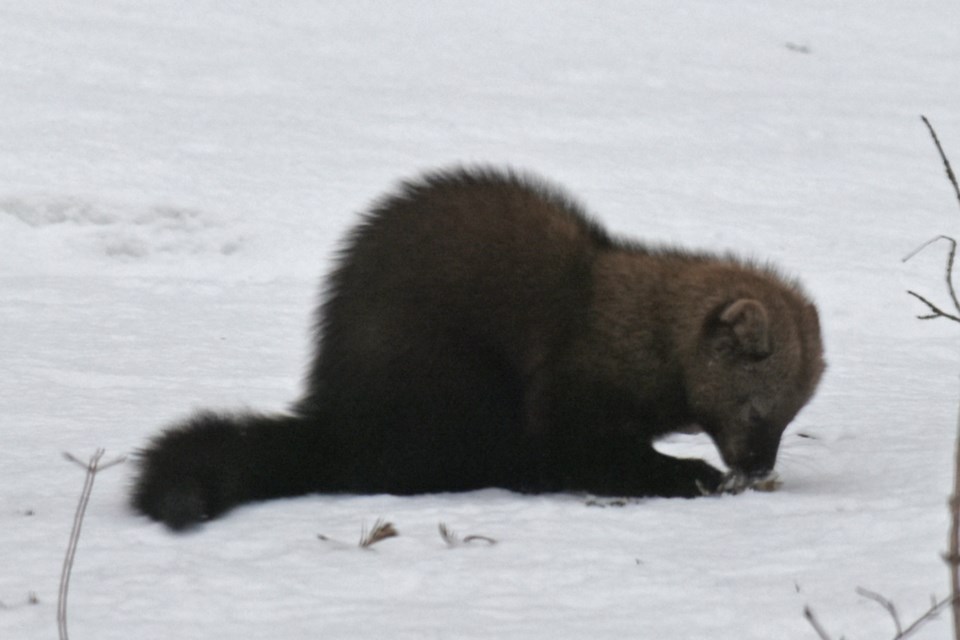To get an accurate daily tally of the birds that use our backyard feeders requires multiple views out the kitchen window.
First glance may reveal three chickadees, six juncos, a blue jay and a red squirrel. Second glance a few minutes later reveals a cardinal, five chickadees and a goldfinch. Third glance I note that only a white-breasted nuthatch and a fisher are in the yard.
Waaaait a minute… a fisher?
Indeed, there it was, snuffling around as if it owned the site. We have often found the tracks of fisher on our property, the paired impressions left behind as it bounded about the woodlots; but to actually see one of these critters was a real treat. The camera was snatched up and several staccato clicks of the shutter ensued while trying to capture the shadowy figure through two panes of cloudy window glass.
Quick backstory to this sighting: two days ago a ruffed grouse hit one of our windows and was rendered dead. The carcass was first discovered by one of our cats (probably ‘George Weasely’) and brought inside the garage.
Said semi-dismembered carcass was then discovered by Julie who cleaned up the mess and threw the remains over the yard-side fence. This depot of meat and feathers had attracted the fisher.
I have had only a couple opportunities to actually see a wild fisher, so looking at this one was a bit of challenge to determine if it was big, small, male, female, adult or yearling. Adult males are said to be large and dark furred. This one looked medium in size with grizzled brown fur, so I’m guessing young female. Perhaps, maybe.
Later that day as Julie went on a bit of a wander around the property there were fisher tracks ‘everywhere’: in the field, in the pines, in the hardwoods, around the willow shrubs. Either this was a very active individual or a small troupe of fishers had traversed the landscape last night.
Their tracks are almost perfectly round and large for their body size. This allows them to stay on top of the snow, like snowshoes, and travel fast and far. Rarely are claw marks visible as, like a cat, they can retract their very sharp claws.
However, knowing that fisher are usually quite solitary animals, I am now supposing it was just two animals, perhaps a male and female. January is mating time for this species and this cavorting around the woodlot may be part of the fisher’s wooing ritual.
An interesting thing about fisher reproduction is that the fertilized embryo can be held in suspended development for up to 11 months! Immediately after giving birth, the female will mate again, thus the females are constantly in a state of pregnancy or lactation.
Our 15-year-old pine tree plantation has become a home for cottontail rabbits, snowshoe hare, meadow voles, ruffed grouse, red squirrels and the occasional porcupine, all of which are on the menu of a hungry fisher. But the hunting range of this top predator is quite large, so it may be weeks between visits to our place.
Whenever I think ‘fisher’ I think of a tree-climbing critter, but apparently that notion is incorrect. Although very capable of climbing trees, these hunters prefer to lope along the ground sniffing out hidden furry morsels. But when the need to climb presents itself, fisher can go up and down a tree trunk with the agility of a squirrel.
Part of this climbing ability is due to the hind ankles being able to swivel 180 degrees, thus providing attachment to the bark even in a head-down position. This is known as ‘bad news’ for squirrels and porcupines.
While on the topic of what a fisher eats, note that they rarely eat fish. Maybe a freshly expired salmon on the spring spawning run, but not usually a part of their diet. The name comes from the French word “fiche” which is to describe a European animal that some would call a polecat. As few early explorers and fur traders were keen biologists, they assumed the pelt in hand was from a polecat, or fiche.
Had to laugh when, as I was looking out the window to watch the fisher depart, a cheeky red squirrel popped his head out of a hollow post as if to say “Yeah, that’s right, move along, keep going, we don’t want your kind around here.”
I think that red squirrel had best keep an eye open and check the shadows.



